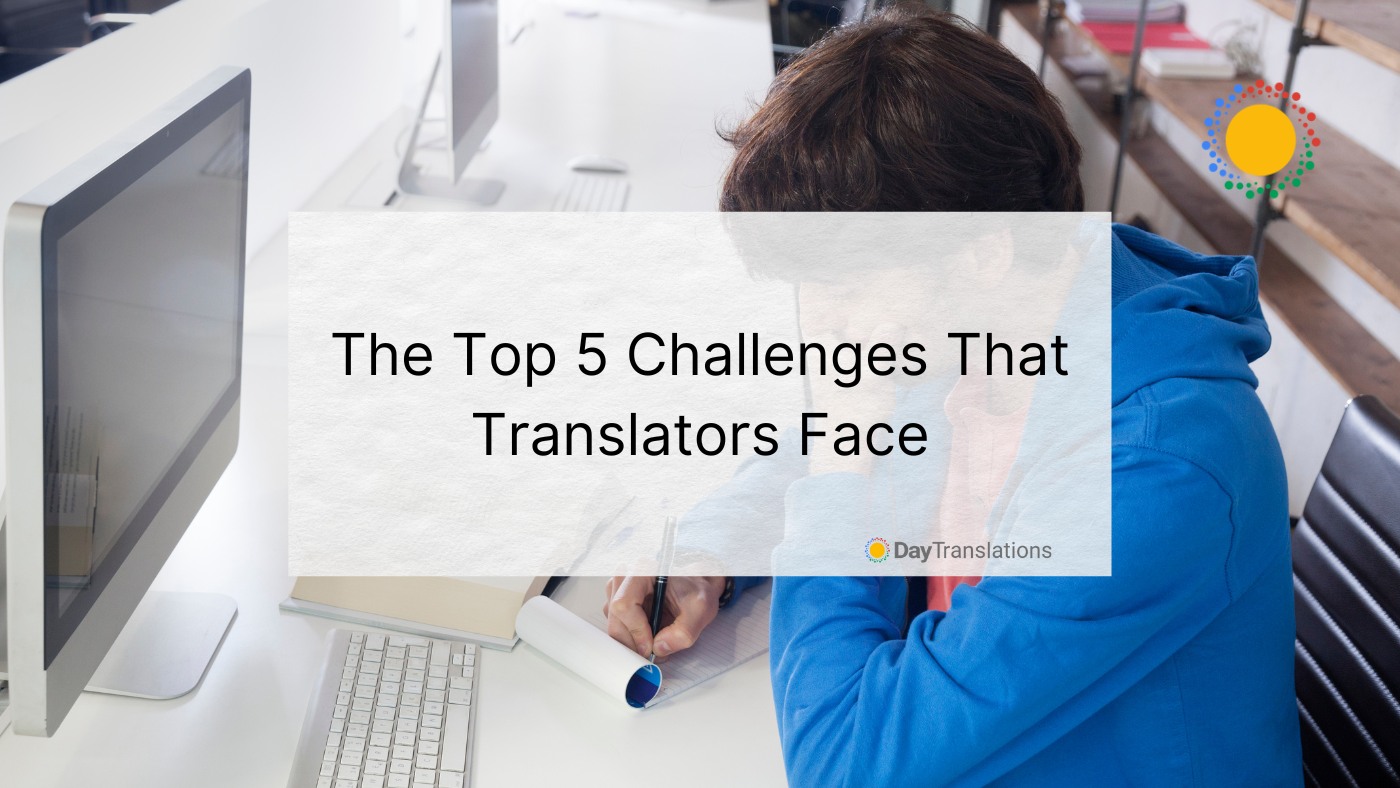Like any other profession, translation is a job where many common challenges are faced even by experts. Translators are trained individuals who understand the linguistic nuances required whenever they are doing translation work and know that there is no room for error. Still, each translation job is unique, thus challenges are ever present in the job.
Here are 5 Challenges That Translators Face
Language Structure
The challenge comes when the language is complex. An English sentence comprises a subject, verb and object. In some languages, the order is different. In Farsi for example, a sentence is made up of a subject and an object before the verb. In other languages such as Arabic, the subject pronoun is written as part of the verb, which then determines the voice of the sentence and the gender of the subject.
Culture
Many of the spoken dialects are woven into many languages, which can affect content. Culture also plays a major part in the use of a language. Each language has a structure that is unique to it, and it is this structure that directly affects the simplicity and level of accuracy of translation. If the language is simple, the translation is also easier and simpler.
Compound words
Compound words are composed of two or three nouns and adjectives that are combined. There are three forms of compound words:
Closed form (like keyboard, notebook, childlike, firefly)
Hyphenated form (like six-pack, mass-produced, over-the-counter)
Open form (like attorney general, full moon, real estate, post office)
Some of the compound words could be straightforward in reflecting their meaning, such as underground, afternoon, seashore. However, there are compound words that only mean half of the term, such as bookworm and bellboy. There are also words that provide another meaning altogether, as in the case of butterfly, which does not mean butter or fly, or the word deadline that has nothing to do with line or being dead.
Missing terms
There are languages where terms for certain objects or actions do not exist. In the United States for example, an extra room in the house where guests are allowed to sleep is called a guest room. In Greek, such a room is called ksnona, while in Italian, a guest room is called camera per gliospiti.
Words with multiple meanings
The use of a word or words in a sentence could give them different meanings. There are words that sound alike (homonyms) such as scale (of a fish) and (weighing) scale. There are also words spelled similarly that sound different (heteronyms), like windy (day) and windy (road). Some other examples include excuse, polish, absent, alternate, minute, contest, record and many more such words. This also applies to idioms, similes and metaphors.
What should a translator do when faced with these common issues? Translation work requires meticulousness. The translator must be well read, have a good knowledge of vocabulary of both the source and target languages and consult dictionaries, thesauruses and other reference books to find the appropriate terms.
What do you think? Did we miss any common challenges translators have to face everyday? Leave your thoughts in the comments below.














Carmen
Posted at 22:06h, 22 AprilI agree that these are challenges translators face everyday, but I think one of the biggest challenges for a translator is a text poorly written, unclear and lacking coherence.
Estoy de acuerdo que estos son retos que los traductores enfrentan todo el tiempo, pero pienso que uno de los mayores retos para un traductor son los textos mal redactados, confusos y faltos de coherencia.
Day Translations
Posted at 09:03h, 28 AprilThank you for your feedback Carmen. It’s true, we’ve received that comment a lot and we know how hard it is to “work out your magic” when you get a document that is poorly written. Have you had one of those cases? Regards!
Gracias por tu comentario Carmen, Es cierto, hemos recibido este comentario antes y nosotros sabemos lo difícil que es hacer “magia” cuando te dan un documento mal redactado. Has tenido alguno de esos casos? Saludos!
Rocío Rodríguez
Posted at 10:35h, 24 AprilI think another challenge nowadays is the competition with CAT tools that a translator has to face. In many agencies it is a CAT tool the one that proofreads and revises the translator’s work, for me it is totally absurd and unfair, because a machine cannot substitute a human being in this matter. The CAT tool takes into account only one meaning for a word, even when there could be many more suitable, so localization is not possible to verify with it. And this also can deliver a very confusing and incoherent result.
In my opinion, technology is a matter that has to be handled very carefully in order to use it only where it can be used, and we have to take into account that it will never substitute human potential.
Thank you.
Day Translations
Posted at 09:53h, 28 AprilRocio, I completely agree with you, technology is there to help mankind, not to replace it. Thanks for your comments.
Alice Veillon
Posted at 16:01h, 24 AprilHello,
I think this article is pretty complete. They are challenges that we are facing as translators. Translating abreviations are also a challenge to me sometimes…
Day Translations
Posted at 09:23h, 28 AprilAlice, thank you very much for your take on the article. You know what, after I read your comment, I did some research and found this article that can help you translate abbreviations with ease. http://www.velior.ru/2013/06/07/do-you-translate-abbreviations-or-leave-them-untranslated/
Au revoir!
Day Translations
Posted at 11:48h, 30 AprilJoaode, thanks for your comments. I would say, most(not all) of the technical terms should not be translated, like DNS or IP. It depends on the case also. Thanks for commenting.
AK Janjelo
Posted at 11:38h, 01 MayHello,
Those are big challenges yes, but I know nowadays with the freelance work mostly based online that they come in the 2nd level of challenges since the 1st level is related to the agencies being the middlemen between the work and us as freelancers. The biggest 2 challenges are: 1- The loyalty of the agency (It’s easy for them not to be loyal and just look into the pool of translators for anyone to get the job done) 2- The PMs, aside of lack of loyalty, there are many of them whom simply you dont like to get emails from them (that IF they contacted you).
Anything else is not a core problem since every craft has its difficult aspects. CAT software can never replace the human judgment, the poor source text, the challenges related to terms and even the culture can increase your experience and level of doing your job. But how can you deal with an agency that don’t know what loyalty is? Or a PM who is in most of the time in a cold/stiff mood? (Even though I do know that the job of the PM is hectic and draining, but thats why we have more than one PM in every company), The only way is to move out and they will just go to the next translator in line.
Because of that, the reasons why I give priority to my 3 main clients are their PMs (I have a list of top PMs) AND their loyalty to me that put me in a position where I am willingly loyal to them.
Regards
Day Translations
Posted at 12:44h, 08 MayHey there, thank you very much for your feedback.
Adrian
Posted at 13:46h, 01 MayStrange you missed delivery deadlines. Not only “same day turnarounds” but others with unrealistic delivery dates. And of course those who want prices and commitment to a delivery date before even receiving the source
Day Translations
Posted at 12:46h, 08 MayAdrian, thank you for your feedback. Same day Turnarounds are definitely a challenge.
Arshid Jamil
Posted at 17:05h, 01 MayThe challenges (for translators) that everyone seems to be talking about is actually what our job ( as translators) is, therefore I don’t consider these as ‘challenges’ that is what translation is all about, if if was not so, then anyone who speaks two languages would become a translator.The only challenge that I feel is indeed a challenge is what Carmen has pointed out ‘a text poorly written, unclear and lacking coherence’.
Day Translations
Posted at 12:46h, 08 MayArshid, thank you for your feedback.
Maria Aparecida de Aragãod a Costa
Posted at 13:36h, 02 MayBeim Dolmetschen ist die Übertragung von Bibel- oder Coranstellen schwer. Es gibt bereits die offizielle Übersetzung, aber in diesem Fall hat man nicht immer die heilige Schrift bei sich.
By ad hoc interpreting of Bible’s or Coran’s passages…
Day Translations
Posted at 12:49h, 08 MayDanke für Ihre Meinung nach
Sjoe!
Posted at 20:05h, 02 MayNot really. The top 5 challenges are:
1. increasing underestimation, undervaluation and underpayment of translation;
2. tougher competition exacerbated by globalisation;
3. markets shrinking under crisis;
4. increasing need for better understanding complex subjects; and
5. deteriorating quality of source language.
Day Translations
Posted at 12:51h, 08 MayVery nice insights, thanks for the feedback
igs terious
Posted at 06:30h, 08 FebruaryI made the most money ever on translation precisely during the “crisis”
María Helena
Posted at 20:25h, 04 MayEstoy de acuerdo con Carmen, la mala redacción, la falta de coherencia y la ortografía, que es el menos malo, pero da que hacer. Me fastidio cuando me tengo que comunicar con un “profesional” en cualquier rama para preguntarle ¿qué quisiste decir con esto y aquello? Pareciese que en las universidades no se enseñara ya el castellano.
Day Translations
Posted at 12:51h, 08 MayCompletamente de acuerdo Helena, gracias por tus comentarios
Language translation
Posted at 15:16h, 05 SeptemberYes, absolutely correct points I agree with you. Thanks for sharing the information.
language translation
Posted at 15:30h, 05 SeptemberExactly. I completely agree with you. Challenge is the second name of life. so we have face this everywhere. Nice and informative article. Thanks for sharing the information.